The architectural gem of Yazd, Dolat Abad Garden, is listed as a UNESCO World Heritage Site and is considered to be one of the most beautiful Persian gardens. It was built more than 200 years ago for a variety of purposes, and today it accommodates a large number of visitors to Iran.Yazd’s Dolatabad Garden (Dolat Abad Garden) is a stunning adobe city with a thriving artistic community. This garden displays a variety of arts and crafts, including carpentry, Qanat, and wind catchers. Historically, Qanat, an antiquated way of supplying water, was used to irrigate Dolat Abad’s large garden.
Introduction to Dolat Abad Garden in Yazd
Yazd is surrounded by the warm embrace of the sun, yet there is a lovely mood that temporarily removes you from the city and its problems. Tourists are welcomed by a straightforward entry with a sign for Dolat Abad Garden on this city’s Dolat Abad Boulevard.You should pass a lovely porch on your way there that welcomes you with handicraft shops selling ceramics and soothes your spirit with a showcase of Iranian architecture. As soon as you enter, a towering windbreak that has grown to the height of the center of the blue sky can be seen at the end of the garden corridor.One of the oldest gardens in Iran, Dolat Abad Garden is more than 260 years old and is well-known around the world. The 6.4-hectare garden has signs of paradise in every nook and cranny that transport visitors to another planet. There are several fruit trees, including grapes, cypresses, and pines, and in the spring, one can smell Mohammadi and crimson blossoms.We arrive at the legendary Bagh structure, which is situated next to a lake and between some woodlands. It boasts the highest brick windmill in the world and rekindles pride in the distinctive Iranian architectural style.If you look closer and learn more about the garden’s characteristics, you will see how the architects used the principles of design to construct a lush garden in the center of a desert city, creating a singular masterpiece.
Location of Dolat Abad Garden
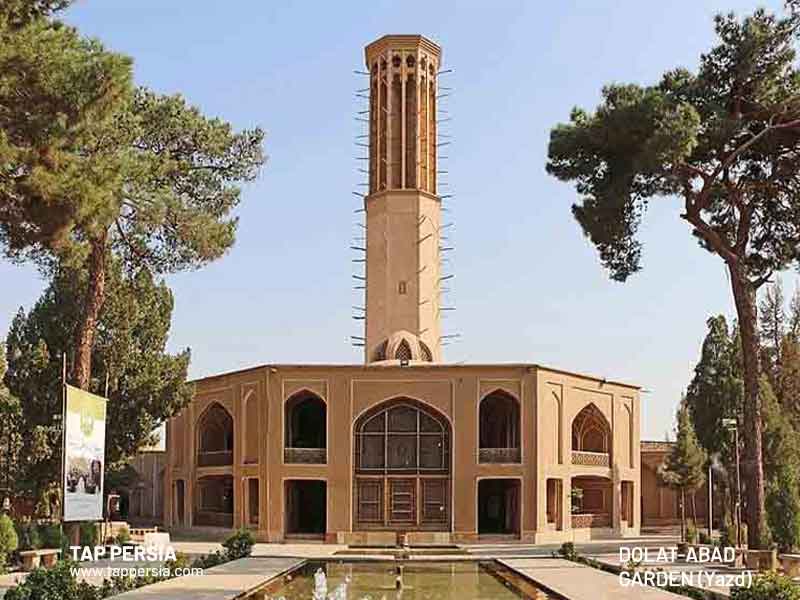
The garden’s main entrance leads to Shahid Rajaei Street, while a second entry leads to Dolat Abad Boulevard. Alexander’s Prison, Lari Ha House, and Amir Chakhmaq Complex are just a few of the Yazd attractions that are close by. Zoroastrian Dakhmeh (Towers of Silence), the Zoroastrian Fire Temple, Rokn Addin Mausoleum, and the Markar Clock Tower, are a few further points of interest.
History of Dolat Abad Garden
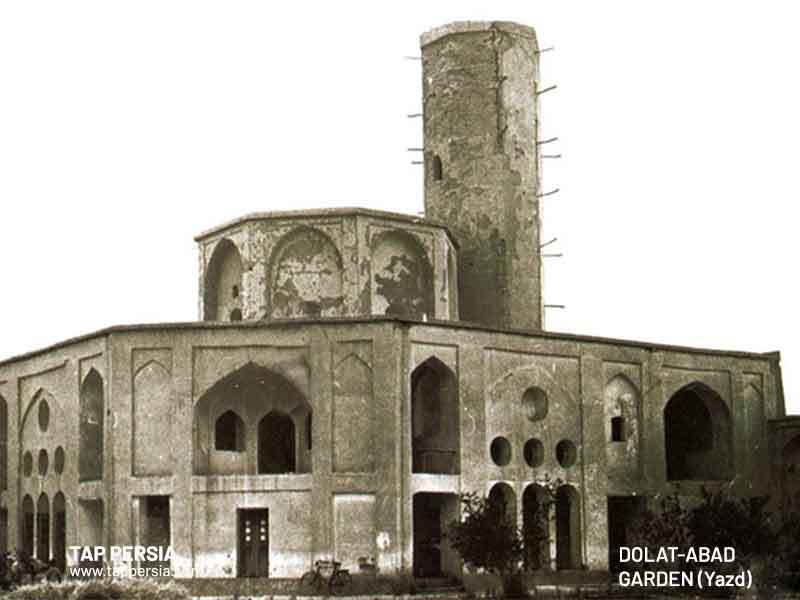
After Nader Shah’s death, Mohammad Taghi Khan Bafqi, who was in control of Yazd, built the garden in 1747. He gave the order to build a 65 km long Qanat with five root branches to bring water from Mehriz to the site to start work. Then he built his home and the capital of his kingdom in the garden.After the original owner of the garden passed away in 1793, it was left in ruins. Considering that the Qanat no longer supplies water for the garden, the garden is being watered using a semi-deep well.Mohammad Vali Mirza, the third son of Fathali Shah Qajar, who served as governor of Yazd in 1811, and Sultan Hossein Mirza, the oldest son of Mass’oud Mirza Zell-e Soltan, who also served as governor of Yazd, both made repairs to the garden and the buildings.The last time it was fixed was between 1975 and 1983, which partially repaired the wind catcher that had fallen. Six towers previously stood within the garden’s enclosure walls, but only one does so now. One of Mohammad Taghi Khan Bafqi’s descendants owns the garden on a personal basis.
Materials used in garden construction
The most important material utilized in the garden’s creation is marble. This is highly contentious since Yazd marble has long had a distinct reputation for excellence and has a unique and widespread reputation, yet there is no evidence of it at Dolat Abad Garden. These stones were transported here from the city of Maragheh.
Different parts of Dolatabad Garden
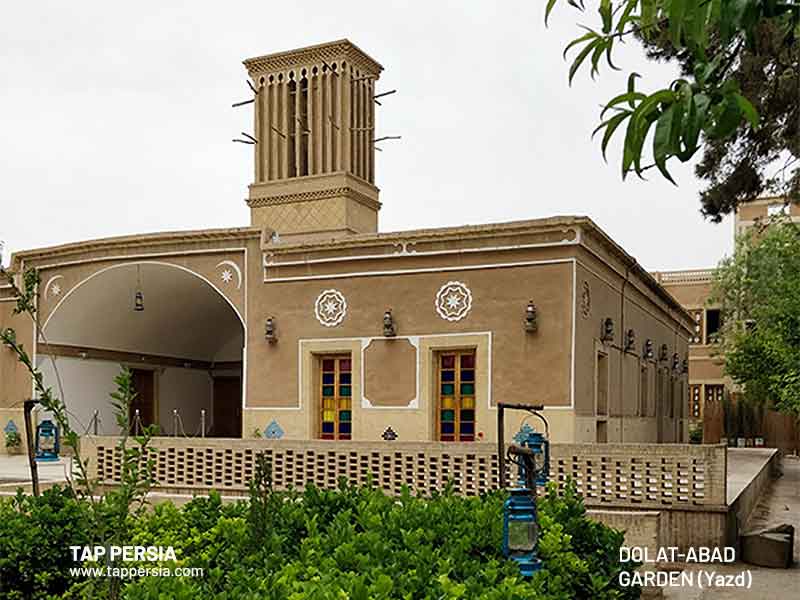
As we’ve already said, the garden was separated into two main sections: Internal Courtyard and External Courtyard (Persian: Jelo-Khan), and it served as both a private house and a government base. The two areas were entirely divided, and even the inside courtyard had a guard and gatekeeper on duty.
Internal courtyard
The Vestibule (Summerhouse), the Harem, the Behesht Aeen Garden, the Tanbi Hall, the Kitchen, the exclusive water reservoir, the watchtower, and the summer and winter stables are all included in this section.Vestibule
This garden’s two-story, octagonal entrance and the 33.8-meter windcatcher perched above it are its most noteworthy features. It was cleverly constructed to create a lovely interaction between the water and the breeze.The breeze in the vestibule mixed with the water in the house and beneath the windcatcher produced a cooling effect. All three alcoves and other halls received the chilly air that was moving beneath the windcatcher.Due of this, they also referred to it as a summerhouse. Three alcoves, an octagonal wind catcher, an Iranian springhouse (Hoze-Khaneh) with marble pools, reticular doors, a foyer, and two storerooms made up this home.Tanbi Hall
Tanbil Hall, a lavish room with a square-shaped windcatcher on top, is located on the vestibule’s western side. There are hallways, clerestories, and bedchambers all around this hall.Behesht Aeen
The family that resided in this garden used it as their winter home. Cherry and pomegranate trees can be observed in the region between these two homes, which is just in front of the entryway.Watchtower
The adobe walls enclosing the garden support the watchtower.External Courtyard
On the north side of the park, the outside courtyard had a frontage and gateway, a mirror hall, a Tehrani Hall, two watchtowers, two small bazaars, and a public water reservoir. This area of the garden was used for sporting events, official celebrations, and as a rest area for caravans.Good atmosphere of Dolat Abad garden
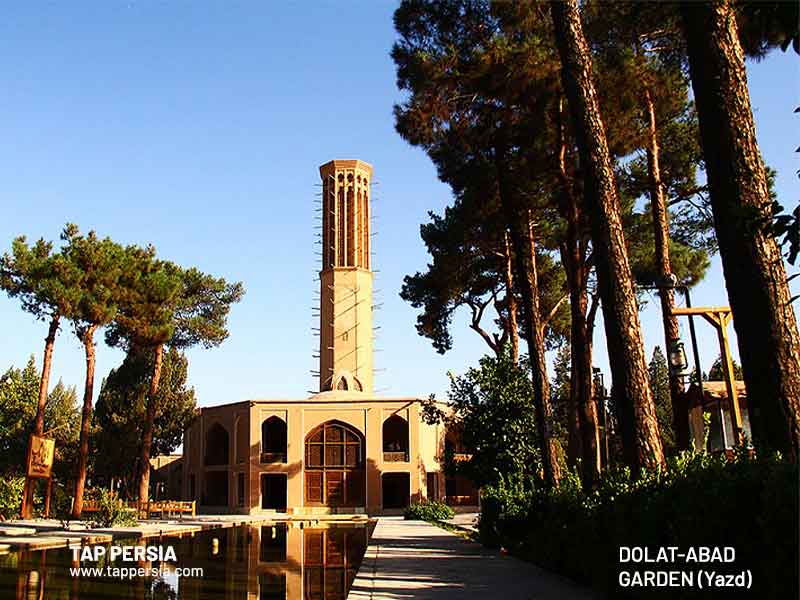
There is a sizable entrance outside the garden that leads to handcraft stores. While it is difficult to ignore the exquisite ceramics and world of Termeh, you are unconsciously lured to the garden when you notice the little water fountains in front of you. Everywhere you look, tall trees are lovely, and lanterns are hung next to them; at night, the lanterns light up and give the garden a different appearance.
The plants in the Dolat-Abad garden
Iranian gardens often utilized their plants for three purposes: harvesting, decoration, and casting shadows.The garden was mostly made up of shaded, useful trees, with minimal contribution from flowers and decorative plants. No different from any other garden is this one. The garden contains two areas, one for private use and the other for events and sports, as we previously said.There are clovers on the garden’s strip between its two buildings and in the center of the central axis, and cherry and pomegranate trees can be seen on both sides of the bar. The majority of the other trees in the garden are cedar and pine. Additionally, a grape tree is positioned inside each plot. Another abundant feature of it is rose bushes.
Water Demonstration in Dolatabad Garden
Since water is one of the main characteristics of Persian gardens, Dolat Abad Garden contains more water features than any other Persian garden. The water flow system in this landscape is made up of ponds, pools, and both apparent and hidden water channels.The first place you’ll encounter water in the vestibule home is in a marble pond beneath the windcatcher. It then flows through three other rectangle-shaped ponds in three alcoves before ending at a pool in the mansion’s center. The water in this garden has traveled further than this.After making several turns, it finally arrives at the large fountain, where it performs a dance for the onlookers. The mansion is perfectly reflected in the pool because it is positioned such that its main axis lines up with it.There used to be a water circulator where the water would flow, but that is no longer the case. Water rushes into the “Behesht Aeen” garden’s twelve-sided pool, fills three other rectangular pools, and finally empties onto the nearby farms and villages.
Where does the water come from?
In the past, Mehriz Qanat supplied the water for this garden. The longest qanat in Yazd, Mehriz, traveled more than 50 km. After irrigating the farmlands of Mehriza and turning on a few watermills, it made its way to the 70,000 m2 Dolat Abad Garden.It filled the ponds and pools, watered the grapevine, pomegranate, cedar, and pine trees in the garden, and then went on to other surrounding farmlands. Today, just 45,000m2 of this garden is still standing.
When and How to go to Dolatabad Garden
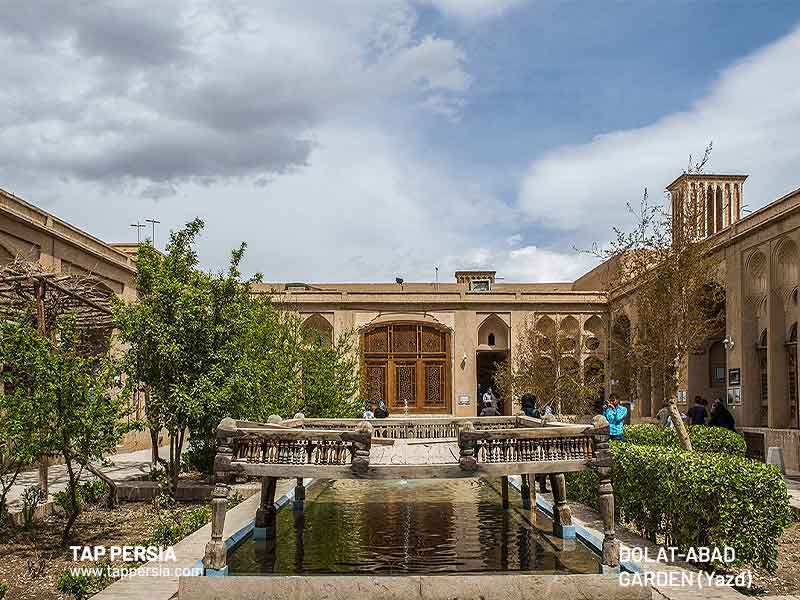
Yazd is a desert city, thus the best months to visit are early spring, March, April, and May, as well as from October to February. You have a variety of alternatives for getting to Yazd from anywhere in Iran, including aircraft, buses, railroads, and private vehicles.Since the garden is in the middle of the city, traveling there on your own is rather simple. However, if you’re interested in learning more about the many features of this garden, you can discover tours that will also take you around the rest of the city.
Where to Eat near Dolat Abad Garden
Nearby restaurants where you may enjoy delectable meals, snacks, and drinks include Dolat Abad Café, Melli Restaurant, Bartar Restaurant, Sholi Kadeh, Enghelab Restaurant, Hall and Restaurant of Dolat Abad Garden, and the Diamond Restaurant.
Where to Stay near Dolat Abad Garden
If you wish to stay close to Dolat Abad Garden, there are several hotels and hostels from which to select. Some of these options include the Safaiyeh Hotel (5-star), the Yazd Arg-e Jadid Hotel (5-star), the Yazd Star Hostel, the Vali Traditional Hotel (3-star), the Silk Road Hotel, the Lab-e Khandagh Historical Hotel (3-star), the Malek-o Tojjar Hotel (4-star), the Firoozeh Traditional Hotel (3-star), and the Fahadan Museum Hotel (traditional hotel).




Comment (0)